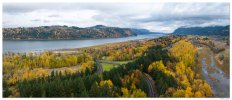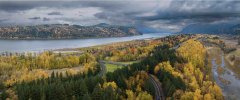According to the old timers who have been in the area since dirt was invented this year's fall colors have been off the scale and the best since 1978. No idea what variables made this year's colors so spectacular but I'm sure glad I got to see and shoot them. This is a 3 shot panorama at 24mm with a viewpoint just above Mirror Lake in Rooster Rock State Park on the Oregon side of the Columbia River. This was taken about 2 weeks after the previous panorama I recently posted. Click through for a more detailed view.

Comments and critiques always welcome.

Comments and critiques always welcome.













